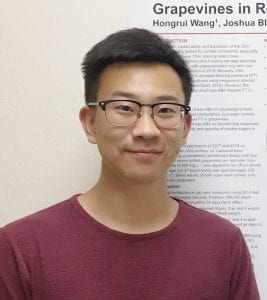From belowground plant interactions to the transcriptional response of grapevine to chilling – these are just two of the diverse graduate student projects recently funded through the Schmittau-Novak Small Grants Program. Supported by a bequest from the estate of Jean Schmittau in honor of Joseph Novak, Plant Biology Professor Emeritus, the Schmittau-Novak Small Grants Program is designed to provide graduate students in the School of Integrative Plant Science with the opportunity to experience the process of writing and reviewing proposals, and implementing a research plan of their own design. Eight proposals were selected for Spring 2022 funding. The program is directed by Dan Buckley and Teresa Pawlowska.
Understanding the trade-off between nutrition and quality in biofortified cassava through a gene-metabolite network analysis
 Seren Villwock is a graduate student in the Field of Plant Breeding working with Jean-Luc Jannink
Seren Villwock is a graduate student in the Field of Plant Breeding working with Jean-Luc Jannink
Cassava (Manihot esculenta) is important for the food security of smallholder farmers in tropical regions around the world, a population that experiences high rates of childhood blindness and mortality due to vitamin A deficiency. Efforts to increase the provitamin A content of cassava have been hindered by undesirable decreases in dry matter content, which is important for starch yield and cooking quality. The goal of this project is to determine whether the negative correlation between carotenoids and dry matter can be overcome through breeding, or if the traits are intrinsically connected by a metabolic trade-off. With a panel of 78 African and Latin American cassava lines that vary in carotenoid content both across genotypes and across tissue layers within the same root, I will conduct a gene-metabolite network using RNAseq, HPLC-UV, and enzymatic assays. To investigate the hypothesis that increased carotenoid biosynthesis induces altered regulation of carbohydrate metabolism, I will examine how carbohydrate metabolism shifts in association with carotenoid metabolism across root tissue layers, and how those patterns differ between African and Latin American lines. This project will provide insight into the regulation of carotenoids in starchy tissues and help inform breeding strategies to mitigate the trade-off between provitamin A and dry matter in cassava and other crops.
Bacterial Organic Adhesives in Soil
 Morgan Irons Morgan A. Irons (she/her/they/them) is a Ph.D. candidate working with Johannes Lehmann to examine how bacterial organic adhesives affect carbon mineralization and sequestration through organo-organic and organo-mineral interactions in aggregates.
Morgan Irons Morgan A. Irons (she/her/they/them) is a Ph.D. candidate working with Johannes Lehmann to examine how bacterial organic adhesives affect carbon mineralization and sequestration through organo-organic and organo-mineral interactions in aggregates.
The proposed work will use atomic force microscopy, scanning transmission electron microscopy, and spectroscopy techniques to obtain a mechanistic understanding of the spatial and chemical complexity of bacterial organic adhesive in soil aggregates, understand how that, in turn, confers persistence to other soil organic matter and carbon, and determine the chemical and surface morphology mechanism of adhesion between model bacterial species and relevant organic and mineral substrates. As soil contains the largest terrestrial pool of organic carbon (OC), understanding how OC occludes and turns over in soil is integral to accurately predicting and managing carbon sequestration and long-term soil fertility. The research will thus contribute to a more holistic understanding of how soil microbiomes affect carbon cycling. It will also contribute to the development of more informed management strategies for combatting climate change and soil degradation affecting plant productivity and biodiversity in agricultural systems.
Soil Modulation of Intraspecific Belowground Plant-Plant Interactions
 Mariana Devault is a Ph.D. Candidate advised by Johannes Lehmann in the Soil and Crop Sciences Section.
Mariana Devault is a Ph.D. Candidate advised by Johannes Lehmann in the Soil and Crop Sciences Section.
Plant-plant interactions are modulated by the transfer of information between emitters and receivers. In the rhizosphere, information exchange can occur through the exudation of soluble organic compounds by living root cells and may trigger changes in spatial distribution and foraging strategy of non-self neighboring roots. Such changes can affect the ability of plants to acquire water and nutrients from soil and allocate carbon to aboveground biomass. My doctoral research aims at investigating the impact of root exudates adsorption by biochar—a soil amendment whose typical large surface area is abundant in functional groups—on non-self roots behavior and the development of co-existing kin plants. In this project, the Schmittau-Novak grant will enable the use of techniques such as LC-MS for root exudates metabolite profiling and X-ray computed tomography for root system imaging.
Field-Based High Throughput Plant Phenotyping to Characterize Plant Architecture, Growth Stages, and Yield Estimation in Hemp (Cannabis sativa L.)


Maylin Murdock is a first-year Ph.D. student in Larry Smart’s lab, majoring in Plant Breeding and Genetics (PBG). She is interested in digital agriculture and her research focuses on remote sensing and high-throughput phenotyping applications in hemp breeding and its integration into selection practices.
Tian Qiu is a second-year Ph.D. student working in the Cyber-Agricultural and Intelligence Robotics (CAIR) Lab, majoring in Electrical and Computer Engineering (ECE). His background is in computer engineering/science, specifically, machine learning and computer vision. Currently, he is interested in developing next-generation smart agriculture systems using cutting-edge technologies.
Hemp (Cannabis sativa L.) is a versatile crop cultivated for grain, fiber, medicinal and recreational purposes. The production of hemp has rapidly expanded over the last decade, and as of last year, the United States (US) legalized hemp production in all states for commercial and research purposes. Demand for CBD drove a rapid increase in hemp production in 2019, but current commercial interest is in the production of nutritious human food and animal feed ingredients and sustainable bioproducts with net negative greenhouse gas emissions. Given the potential for expanded hemp acreage and the lack of long-term breeding programs in the US, there is an urgent need to characterize phenotypes related to yield and quality that will accelerate hemp breeding. It has been shown that the morphometric phenotypic traits of hemp provide a better understanding of the physiological and genetic mechanisms of plant growth and development and are important indicators of biomass yield. However, traditional biomass yield estimation relies on human visual and hand-measured assessments of architectural phenotypes, which are time-consuming, error-prone, and expensive. Hence, there is a critical need to develop high-throughput plant phenotyping (HTPP) approaches to the characterization of plant architecture and plant growth for biomass yield and quality estimation to advance breeding efforts for hemp cultivars. The overall goal of this proposal is to develop an aerial sensing and analytical system to characterize hemp plant morphometric traits for biomass yield estimation. Our project objectives are to (1) collect ground-based and HTPP data using aerial hyperspectral imaging systems (HSI) and LiDAR, (2) develop 3D structural plant models using aerial LiDAR data and compute vegetation indices related to plant growth using hyperspectral images, and (3) evaluate the contribution of HTPP hemp plant architectural traits and identify the optimal traits toward biomass yield estimation. The findings from our research will enable the research and development of methods to quantify flowering time, grain yield, cannabinoid levels, and possibly fiber quality in future work.
Bioinformatic and functional characterization of TAL effectomes of Agrican strains of Xanthomonas oryzae pv. oryzicola
 Shivranjani Baruah is a graduate student in the Field of Plant Pathology & Plant-Microbe Biology working with Adam Bogdanove
Shivranjani Baruah is a graduate student in the Field of Plant Pathology & Plant-Microbe Biology working with Adam Bogdanove
Bacterial leaf streak (BLS) is caused by Xanthomonas oryzae pv. oryzicola (Xoc) and is an emerging disease of rice in several countries within Africa. Xoc has a vast repertoire of Transcription Activator-like Effectors (TALEs) which are a class of the Xanthomonas Type3 Secreted Effectors (T3SE). TALEs contribute to virulence by upregulating transcription of Susceptibility (S) genes in rice. Certain TALEs show avirulence activity and target Executor (E) genes, which elicit a hypersensitive reaction (HR) characteristic of disease resistance. Since genetic basis of resistance has been shown to be most effective towards managing bacterial diseases in rice, identification of S and E genes is a priority for development of BLS resistant rice cultivars. However, only one S gene and no E gene for BLS has been discovered till date.
This study aims to functionally characterize TALEs conserved across geographically diverse African Xoc strains by assessing their contribution to virulence in an effort to identify S genes in rice. In addition, it also aims to screen for avirulence activity of TALEs on a diverse panel of rice accessions with a long-term goal to identify E genes. Knowledge generated through this project is expected to contribute to development of BLS resistant rice varieties.
Identification of tomato structural variants to understand the link between genotypic and phenotypic diversity
 Anna Hermanns is a third year PhD student in the Field of Plant Breeding, advised by Jim Giovannoni. Her research focuses on the identification of structural variants (i.e. mutations >50 bp in length) in the genomes of wild and modern tomato accessions, and the impact of the variants on gene expression, to better understand genotype-phenotype correlations.
Anna Hermanns is a third year PhD student in the Field of Plant Breeding, advised by Jim Giovannoni. Her research focuses on the identification of structural variants (i.e. mutations >50 bp in length) in the genomes of wild and modern tomato accessions, and the impact of the variants on gene expression, to better understand genotype-phenotype correlations.
Tomato (Solanum lycopersicum) is the world’s most important vegetable crop and is the predominant model for the study of fleshy fruit biology. While many tomato genomes have been sequenced during the last decade, it has been found that, despite the high phenotypic diversity in modern tomatoes, the genetic diversity is wider in wild tomato species, such as S. pimpinellifolium, S. cheesmaniae, and S. galapagense. With recent advances in long-read DNA sequencing technologies, it has been shown that the largest proportion of sequence differences among tomato accessions is ascribed to structural variants (SVs). SVs are defined as differences among genomic sequences of > 50 bp, and are oftentimes missed in short-read sequencing. Importantly, SVs are the basis of many critical domestication and breeding loci through influencing gene structure and expression. Despite the opportunity for discovery of novel gene variants, relatively few tomato genomes have yet been subject to long-read DNA sequencing. My objective is to identify SVs in selected wild tomato accessions, and to investigate their regulatory roles in the context of gene expression and ripening-related phenotypes in tomato fruit. To identify SVs, wild tomato species will be subject to whole genome re-sequencing via Oxford Nanopore technology, in which the reads reach hundreds of kilobases in length. Global gene expression and phenotype data of developing wild tomato fruit are on hand, and will be correlated with the obtained sequence information. The resulting correlations will define a collection of gene-function hypotheses that can be tested in future studies.
Understanding the progression of gene expression release in grapevine during chilling accumulation
 Hongrui Wang is a second year PhD student in the Horticulture Section of SIPS, co-advised by Dr. Bruce Reisch and Dr. Jason Londo. His research focuses on understanding the biology of grapevine in dormant season using omics analysis and developing novel tools to mitigate cold-related damage in vineyards.
Hongrui Wang is a second year PhD student in the Horticulture Section of SIPS, co-advised by Dr. Bruce Reisch and Dr. Jason Londo. His research focuses on understanding the biology of grapevine in dormant season using omics analysis and developing novel tools to mitigate cold-related damage in vineyards.
In parallel to the enhancement of freezing tolerance, grapevine buds gradually shift to endodormancy (inhibition of growth caused by unknown internal molecular lock) to overwinter. Endodormant buds in grapevine remain dormant and unbroken even under growth permissive conditions. After the prolonged exposure to chilling, buds progressively transit from endodormancy to ecodormancy (inhibition growth caused by environmental constraints) and resume the ability to sense environmental change and grow under permissive conditions. However, the underlying mechanism of this transition is unknown. In Hongrui’s proposed project for 2022 Schmittau-Novak Award, he will examine the transcriptome of grapevine during chilling accumulation to identify the molecular mechanism of chilling’s impact on the transition from endodormancy and ecodormancy. The experiment will combine specifically designed field-based sample collections and growth chamber-based sample incubations. Bud transcriptome will be examined for 30 times using 3’RNA-seq, and the RNA-seq data will be processed using gene co-expression network analysis. This approach will hypothetically isolate the genes directly respond to chilling accumulation based on their expression behavior during the experiment. This research will address the gap of knowledge regarding the genetic control of grapevine’s physiology during the dormant season. The findings will serve as foundations for the adaption of grape production under climate change.
Ethnopedology of Urban Farms and Implications on Soil Health
 Ilexis Chu-Jacoby is a graduate student in the Field of Horticulture working with Jenny Kao-Kniffin
Ilexis Chu-Jacoby is a graduate student in the Field of Horticulture working with Jenny Kao-Kniffin
In New York City, many urban farming systems are incorporating traditional ecological knowledge (TEK) to cultivate diverse plantings of food and medicinal crops. However, histories of industrialization have resulted in problematic levels of metal contamination in urban soils, presenting a major challenge for urban growers. To circumvent legacy metal contamination, many urban farms are growing familiar plants in new soils, frequently constructed from composted food waste and landscape materials. These constructed urban soils, commonly referred to as technosols, are distinct from rural agricultural soils, and have yet to be substantially investigated for their unique their agroecological properties. Preliminary data indicates technosols throughout NYC are high in organic matter and vary widely in their composition of microbial communities. They may also be lacking in critical soil health metrics such as sufficient aggregate stability and availability of key nutrients. To assess the effects of these soil health metrics on culturally-relevant crop growth, we aim to co-create a survey of the observed and measured effects of soil health on medicinal plant growth and contaminant accumulation. Following a participatory action research framework, urban farmers from 18 farms across NYC will lead ethnopedological and observation-based analysis of their soils, providing insight and meaning to quantitative measurements of how culturally-relevant and medicinal plants grow, adapt, and thrive in these novel urban soil environments. We will conduct a complementary analysis of these soils with the Cornell Assessment for Soil Health (CASH) framework, characterize the soil microbiome using 16S and ITS Illumina sequencing, and investigate arbuscular mycorrhizal fungi (AMF) infection rates of plant roots. We will use X-ray fluorescence (XRF) to assess metal and metalloid contaminant content of the urban farm soils and utilize a novel strategy of XRF to evaluate metal concentrations of plant tissues. With the data gathered from across the 18 farms, we will determine the effects of differing soil biophysical compositions, contamination levels, and both traditional and novel soil management practices on the growth of urban medicinal plants. This study will be used to facilitate the co-creation of a culturally-relevant, ethnopedological index for urban soil health.

 Synapsis sells vegetable seeds to raise funds to support the research programs of Cornell plant breeders and the activities of our graduate student organization. Every Spring, we offer seed packets of select cultivars that have been developed by our Section’s own breeding programs. These cultivars are not only unique and delicious, they are disease-resistant and high yielding in upstate New York and beyond!
Synapsis sells vegetable seeds to raise funds to support the research programs of Cornell plant breeders and the activities of our graduate student organization. Every Spring, we offer seed packets of select cultivars that have been developed by our Section’s own breeding programs. These cultivars are not only unique and delicious, they are disease-resistant and high yielding in upstate New York and beyond! Seren Villwock
Seren Villwock Morgan Irons Morgan A. Irons (she/her/they/them) is a Ph.D. candidate working with Johannes Lehmann to examine how bacterial organic adhesives affect carbon mineralization and sequestration through organo-organic and organo-mineral interactions in aggregates.
Morgan Irons Morgan A. Irons (she/her/they/them) is a Ph.D. candidate working with Johannes Lehmann to examine how bacterial organic adhesives affect carbon mineralization and sequestration through organo-organic and organo-mineral interactions in aggregates. Mariana Devault is a Ph.D. Candidate advised by Johannes Lehmann in the Soil and Crop Sciences Section.
Mariana Devault is a Ph.D. Candidate advised by Johannes Lehmann in the Soil and Crop Sciences Section.

 Shivranjani Baruah is a graduate student in the Field of Plant Pathology & Plant-Microbe Biology working with Adam Bogdanove
Shivranjani Baruah is a graduate student in the Field of Plant Pathology & Plant-Microbe Biology working with Adam Bogdanove Anna Hermanns is a third year PhD student in the Field of Plant Breeding, advised by Jim Giovannoni. Her research focuses on the identification of structural variants (i.e. mutations >50 bp in length) in the genomes of wild and modern tomato accessions, and the impact of the variants on gene expression, to better understand genotype-phenotype correlations.
Anna Hermanns is a third year PhD student in the Field of Plant Breeding, advised by Jim Giovannoni. Her research focuses on the identification of structural variants (i.e. mutations >50 bp in length) in the genomes of wild and modern tomato accessions, and the impact of the variants on gene expression, to better understand genotype-phenotype correlations. Hongrui Wang is a second year PhD student in the Horticulture Section of SIPS, co-advised by Dr. Bruce Reisch and Dr. Jason Londo. His research focuses on understanding the biology of grapevine in dormant season using omics analysis and developing novel tools to mitigate cold-related damage in vineyards.
Hongrui Wang is a second year PhD student in the Horticulture Section of SIPS, co-advised by Dr. Bruce Reisch and Dr. Jason Londo. His research focuses on understanding the biology of grapevine in dormant season using omics analysis and developing novel tools to mitigate cold-related damage in vineyards. Ilexis Chu-Jacoby is a graduate student in the Field of Horticulture working with Jenny Kao-Kniffin
Ilexis Chu-Jacoby is a graduate student in the Field of Horticulture working with Jenny Kao-Kniffin

